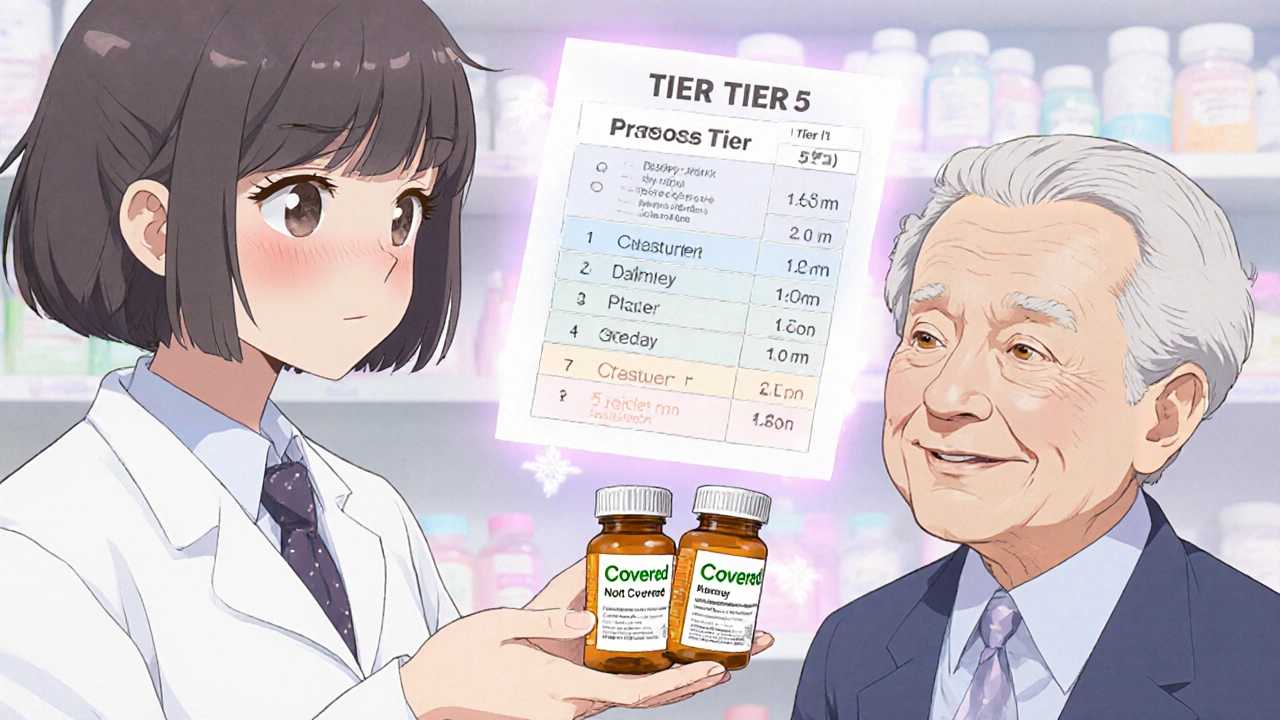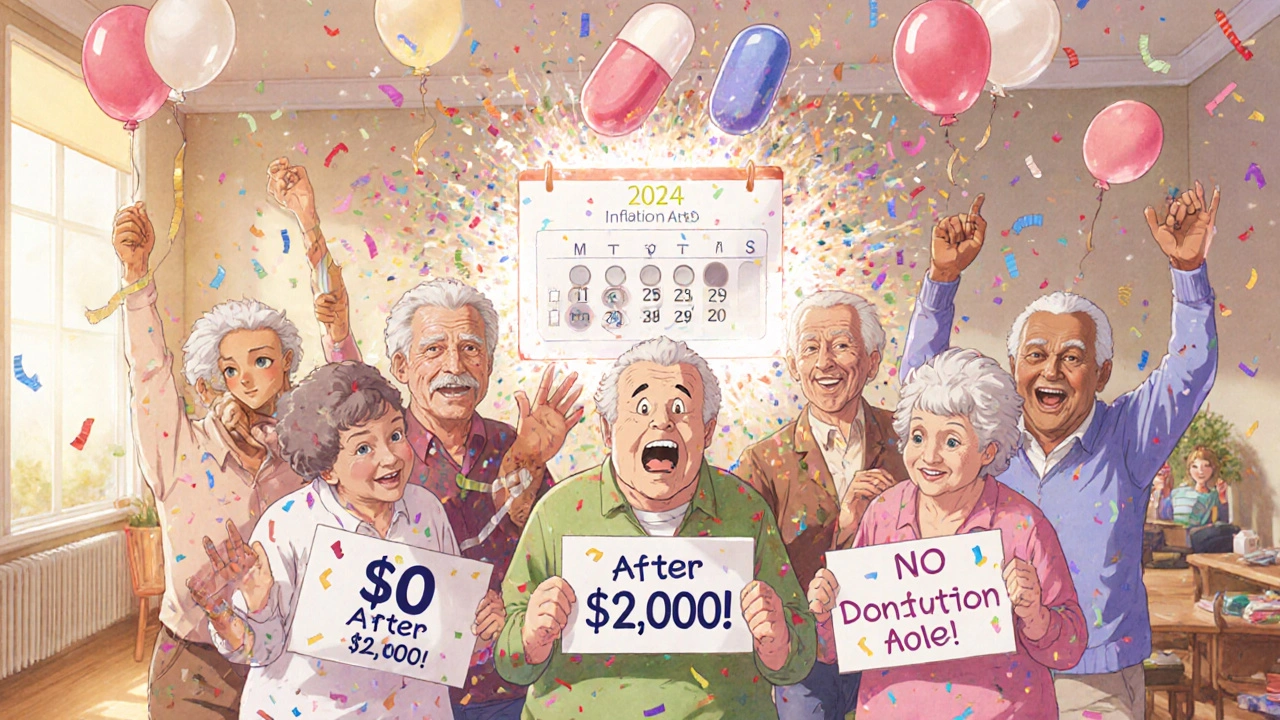By 2025, nearly 92% of all prescriptions filled under Medicare Part D are generics. That’s not just a statistic-it’s the backbone of how millions of seniors and people with disabilities pay far less for their medications. If you’re on Medicare and take any regular pills, understanding how generic coverage works isn’t just helpful-it’s essential to avoid surprise bills and maximize your savings.
What Exactly Is a Medicare Part D Formulary?
A formulary is simply a list of drugs your Medicare drug plan covers. Every Part D plan-whether it’s a standalone prescription drug plan (PDP) or a Medicare Advantage plan with drug coverage-has its own formulary. But they don’t just randomly pick drugs. Federal rules require them to cover at least two different generic options in every major drug category, like blood pressure meds, diabetes pills, or cholesterol drugs. This ensures you have choices, even if your plan prefers one generic over another.How Tiers Work: The Hidden Structure Behind Your Copay
Part D plans organize drugs into five tiers. The lower the tier, the less you pay. Generics live mostly in Tier 1 and Tier 2.- Tier 1 (Preferred Generics): These are the cheapest options. Most plans charge $0 to $15 for a 30-day supply. Think of these as the plan’s top picks-they’re proven, effective, and cost the least.
- Tier 2 (Non-Preferred Generics): These are still generics, but your plan doesn’t push them as hard. You might pay $15 to $40 per month, or 25-35% coinsurance. Sometimes, this tier includes newer generics that haven’t yet become the go-to choice.
How Much Do You Actually Pay for Generics in 2025?
The cost structure changed dramatically on January 1, 2025, thanks to the Inflation Reduction Act. Here’s how it breaks down now:- Deductible: You pay the first $615 of drug costs in 2025. Some plans have a $0 deductible-check yours.
- Initial Coverage Phase: After the deductible, you pay 25% of the cost for generics. Your plan pays the other 75%. This applies until your total out-of-pocket spending hits $2,000.
- Catastrophic Coverage: Once you hit $2,000 out-of-pocket, you pay $0 for the rest of the year. That includes all generics, brand-name drugs, and specialty meds.
Why Generics Cost So Much Less Than Brands
Generics are chemically identical to brand-name drugs. They contain the same active ingredient, work the same way, and are held to the same FDA safety standards. The only difference? Generics don’t have to spend millions on advertising or recoup research costs. That’s why a generic version of a $150 brand-name pill might cost $5. In 2024, generics made up 92% of all Part D prescriptions-but only 18% of total spending. That’s the power of the system working as intended: more people using cheaper drugs = lower costs for everyone.
What Happens When Your Generic Isn’t Covered?
Here’s where things get tricky. Your plan might cover one generic for a drug like lisinopril (a common blood pressure med) but not another-even though they’re both FDA-approved and chemically the same. This is called “therapeutic interchange.” If your pharmacist tries to switch your prescription to a generic your plan doesn’t cover, you could end up paying full price. That’s why it’s critical to check your plan’s formulary before you enroll-or every fall during Open Enrollment. If you find your generic isn’t covered, you can file a “coverage determination” request. According to CMS data, 83% of these requests are approved. Just call your plan or submit a form online. You can even ask your doctor to write a letter supporting your need for a specific generic.How to Find the Best Plan for Your Generics
Not all Part D plans are created equal. Two plans in the same zip code might cover the same generics-but charge completely different prices. Use the Medicare Plan Finder tool on Medicare.gov. Enter your exact medications, including the generic names, and your pharmacy. The tool will show you:- Which plan has your generics on Tier 1
- What your monthly premium is
- How much you’d pay out-of-pocket for the year
What to Watch Out For
Even with all the protections in place, there are still pitfalls:- Annual formulary changes: About 37% of plans change their generic tier placement every year. Your $0 generic in 2024 might jump to Tier 2 in 2025.
- Authorized generics: These are brand-name drugs sold under a generic label by the same company. They’re not always covered the same way as true generics. Check your plan’s list carefully.
- Pharmacist substitutions: If your plan only covers one generic for a drug, and your pharmacist switches you to another, you might get stuck with a higher cost. Always ask if the substitution is on your plan’s formulary.

Real Stories From People on Part D
One user on Reddit, ‘MedicareVeteran82,’ shared that his plan covered one generic for blood pressure but not another-even though both were equally effective. He ended up paying $80 a month until he switched plans and found one that covered his preferred version for $5. Another, ‘SmartSenior2024,’ said her three generic heart meds now cost her $0 thanks to her plan’s Tier 1 coverage. “I used to pay $350 a month before Medicare,” she wrote. “Now I’m saving over $300 every month.”What’s Changing in 2026 and Beyond
The changes aren’t stopping. Starting in 2026, Part D plans must include a “generic price comparison tool” in their member portals so you can instantly see which generic version costs the least. By 2029, the government will start negotiating prices for certain generics-starting with insulin glargine. That means even more savings down the road. Meanwhile, experts predict that by 2027, 95% of Medicare beneficiaries will have access to $0 copays for at least half of their commonly used generics.What You Should Do Right Now
1. Check your current plan’s formulary. Go to your plan’s website and search for each generic you take.Are all generic drugs covered under Medicare Part D?
Almost all FDA-approved generic drugs are covered, but not every plan covers every generic. Each Part D plan must cover at least two generics in each therapeutic class, but they can choose which ones. Some generics may be excluded if they’re for weight loss, fertility, or cosmetic use-those aren’t covered under federal rules.
Why is my generic drug not on my plan’s formulary?
Plans choose which generics to include based on cost, effectiveness, and agreements with manufacturers. Even if two generics are chemically identical, your plan might only cover one because it’s cheaper or they have a special deal with that manufacturer. You can request an exception if your doctor says you need a specific one.
Do I pay more for generics in the coverage gap?
No. Since January 1, 2025, there is no coverage gap for generics-or any drugs. Once your out-of-pocket spending hits $2,000, you enter catastrophic coverage and pay $0 for all covered drugs for the rest of the year.
Can I switch plans if my generic gets moved to a higher tier?
Yes. During the Annual Enrollment Period (October 15 to December 7), you can switch to a different Part D plan that covers your generics at a lower cost. You can also make a special enrollment if your plan drops a drug you need.
How do I know if my pharmacist is giving me the right generic?
Always ask: “Is this the generic my plan covers?” Pharmacists can substitute generics unless your doctor says “do not substitute.” But if your plan only covers one version and you get another, you might pay full price. Check your plan’s formulary or call customer service before picking up your prescription.
Are there Part D plans with $0 premiums and $0 copays for generics?
Yes. Many stand-alone Part D plans have $0 premiums, and about half of them also have $0 deductibles. Some even offer $0 copays for Tier 1 generics. You’ll still pay your monthly premium, but if you take only generics on Tier 1, your out-of-pocket cost for drugs could be $0 after the deductible.
